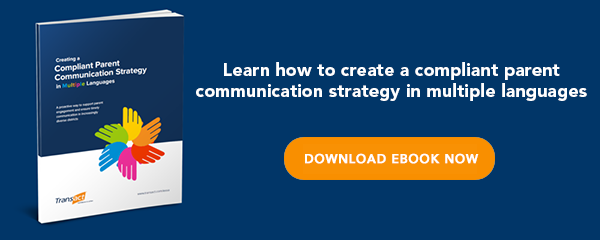
The gold standard of a thriving educational environment is one in which parents and teachers work towards aligned goals, the students have the latest technology at their fingertips at school and home, and communication between parties is welcomed and encouraged.
Book a demo to learn more about our K-12 software solution, ParentNotices:
Of course, supporting student success can be challenging. Bridging the gap between school and home can be fraught with challenges and can impact student achievement. For instance, getting in touch with parents who speak a different language can be nearly impossible without the proper infrastructure or translation services in place.
Studies also show that parental involvement positively affects grade point averages, and a lack of parent participation in the learning process can be detrimental. Moreover, students may have access to technology at school that they just can’t get at home, which can be a barrier to academic achievement.
Taken a step further, one might argue that student success relies on many different relationships to support growth. From educators to school personnel, to families, to others in the community, there must be a firm commitment to student success from all sides to drive home everything taught in the classroom.
The 2016-2017 school year was a transition year for implementing the federal education law initially passed as the Elementary and Secondary Education Act (ESEA) of 1965. The No Child Left Behind Act of 2001 transitioned to the Every Student Succeeds Act (ESSA), signed into law on December 10, 2015. In SY2017-2018, districts began implementing ESSA-related changes, which include requirements to support student success initiatives with students and parents.
Below, we’ll discuss four important ways to promote better student success and bridge the gap between school and home—including laying the groundwork of core values, implementing effective communications strategies, and promoting at-home learning opportunities whenever possible.
1. Agree on core values and objectives
The publication Family-School-Community Partnerships 2.0 discusses the importance of core values when achieving student success at school and home. These values may include:
- Educator relationships. Teachers and families alike have important roles in the child’s learning development. As the publication puts it, “The family is the expert on the child; the teacher is the expert on the curriculum.” Both are educators, and both are significant.
- Parent involvement at home. Encouraging family involvement is crucial and can be effective in any home, regardless of language, income, or family structure. Families should feel confident supporting their students to be achievers to reinforce what they learned in the classroom.
- Parent/teacher communication. It’s critical for parents and teachers to communicate effectively and positively before beginning discussions about academics.
Communicating about and agreeing on baseline values helps align parents, teachers, and students on what matters and the associated goals. Taking time to plan and consider any challenges or difficulties along the way can make a big impact down the line.
2. Seek out communication strategies
Professional educators know how important it is to communicate effectively with students and their families. Communication is at the heart of any meaningful relationship, and good relationships can help carry students through challenging situations in school and at home.
Above all, communication is essential to creating and maintaining high student achievement. And when it comes to bridging the gap between school and home, it’s all about aligning student success goals between the classroom and home.
Challenges can crop up when families speak a language other than English at home. In this case, parent/teacher communication isn’t always as easy as making a phone call or sending a standard parent notification. Sometimes, schools or districts try to do this in-house by hiring a trained translator or interpreter.
While this works in some situations, the cost and burden of hiring additional personnel can create unnecessary strain. Another communication strategy is to work with a language services partner focused on communication compliance to ensure parent notifications are available in all necessary languages. This can help schools feel confident that they are not only bridging the teacher/parent gap but overcoming the language or culture gap as well — not to mention meeting compliance standards for ESSA at the same time.
3. Promote at-home learning
At-home learning opportunities give students a leg up when it comes to ongoing success, and some experts even believe that parental involvement is the single most important factor in a student’s educational achievement. Yet, not all schools have processes or communication plans in place to promote such involvement.
Under NCLB, there were requirements for Parent Involvement. Under ESSA, Title I funds at the district level must be designated for parent and family engagement and include the development of Parent and Family Engagement Policies at both the school and district levels. The inclusion of 'family' and rewording to 'engagement' created a greater emphasis on the importance of the school-home connection.
Of course, at-home learning can happen with or without federal subsidies. At-home learning can refer to educational opportunities like self-motivated reading and writing, community service projects, science and art programs, and more.
4. Grant access to technology
When it comes to student support strategies, technology plays an important role. Technology in schools has changed dramatically in recent years and has a much different place in the classroom than ever before. However, students often have access to advanced technologies in the classroom but lack the same opportunities at home, which can impact their performance and overall success.
For instance, if a student uses a computer every day at school but doesn't have internet access or a computer at home, there could be a disadvantage when it comes to solidifying lessons they learned in the classroom. Furthermore, many parents — while eager to volunteer in their students’ classrooms — may feel a sense of inadequacy when it comes to helping with technology or programs that are not familiar.
Fortunately, many states and districts are developing programs to combat these inconsistencies. For example, Maine’s statewide learning technology initiative led the charge to give students take-home access to technology like laptops and even home internet. A similar program, Power My Learning, helps align students, parents, and teachers at participating schools with equipment, training, and technical support to strengthen learning relationships and raise academic standards.
Another solution is to offer digital literacy programs for parents, which can help parents learn more about the digital programs their students are using and raise their confidence when it comes to helping out in the classroom — and at home.
In summary, bridging the gap between school and home is critical to supporting student achievement — no matter the student’s age, economic status, or native language. Although students spend the majority of their time at school each day, the role of parents, family, and community in student learning is not to be underestimated. Teachers and parents must work together to lay the foundations of strong values, positive communication, and lifelong learning both in school and at home, and move forward using effective communication strategies to grow those values.
Book a demo to learn more about our K-12 software solution, ParentNotices:




